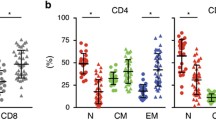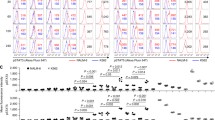Abstract
Regulatory NK cell receptors can contribute to antigen-specific adaptive immune responses by modulating T cell receptor (TCR)-induced T cell activation. We investigated the potential of the NK cell receptor 2B4 (CD244) to enhance tumor antigen-induced activation of human T cells. 2B4 is a member of the CD2 receptor subfamily with both activating and inhibitory functions in NK cells. In T cells, its expression is positively associated with the acquisition of a cytolytic effector memory phenotype. Recombinant chimeric receptors that link extracellular single-chain Fv fragments specific for the tumor-associated surface antigens CD19 and GD2 to the signaling domains of human 2B4 and/or TCRζ were expressed in non-specifically activated peripheral blood T cells by retroviral gene transfer. While 2B4 signaling alone failed to induce T cell effector functions or proliferation, it significantly augmented the antigen-specific activation responses induced by TCRζ. 2B4 costimulation did not affect the predominant effector memory phenotype of expanding T cells, nor did it increase the proportion of T cells with regulatory phenotype (CD4+CD25hiFoxP3+). These data support a costimulatory role for 2B4 in human T cell subpopulations. As an amplifier of TCR-mediated signals, 2B4 may provide a powerful new tool for immunotherapy of cancer, promoting sustained activation and proliferation of gene-modified antitumor T cells.




Similar content being viewed by others
References
Eshhar Z, Waks T, Gross G, Schindler DG (1993) Specific activation and targeting of cytotoxic lymphocytes through chimeric single chains consisting of antibody-binding domains and the gamma or zeta subunits of the immunoglobulin and T cell receptors. Proc Natl Acad Sci USA 90:720–724
Brentjens RJ, Latouche JB, Santos E, Marti F, Gong MC, Lyddane C, King PD, Larson S, Weiss M, Riviere I, Sadelain M (2003) Eradication of systemic B cell tumors by genetically targeted human T lymphocytes co-stimulated by CD80 and interleukin-15. Nat Med 9:279–286
Brocker T (2000) Chimeric Fv-zeta or Fv-epsilon receptors are not sufficient to induce activation or cytokine production in peripheral T cells. Blood 96:1999–2001
Kershaw MH, Westwood JA, Parker LL, Wang G, Eshhar Z, Mavroukakis SA, White DE, Wunderlich JR, Canevari S, Rogers-Freezer L, Chen CC, Yang JC, Rosenberg SA, Hwu P (2006) A phase I study on adoptive immunotherapy using gene-modified T cells for ovarian cancer. Clin Cancer Res 12:6106–6115
Lamers CHJ, Langeveld SCL, Ruijven CMGV, Debets R, Sleijfer S, Gratama JW (2007) Gene-modified T cells for adoptive immunotherapy of renal cell cancer maintain transgene-specific immune functions in vivo. Cancer Immunol Immunother 56:1875–1883
Mitsuyasu RT, Anton PA, Deeks SG, Scadden DT, Connick E, Downs MT, Bakker A, Roberts MR, June CH, Jalali S, Lin AA, Pennathur-Das R, Hege KM (2000) Prolonged survival and tissue trafficking following adoptive transfer of CD4zeta gene-modified autologous CD4(+) and CD8(+) T cells in human immunodeficiency virus-infected subjects. Blood 96:785–793
Park JR, DiGiusto DL, Slovak M, Wright C, Naranjo A, Wagner J, Meechoovet HB, Bautista C, Chang WC, Ostberg JR, Jensen MC (2007) Adoptive transfer of chimeric antigen receptor re-directed cytolytic T lymphocyte clones in patients with neuroblastoma. Mol Ther 15:825–833
Till BG, Jensen MC, Wang J, Chen EY, Wood BL, Greisman HA, Qian X, James SE, Raubitschek A, Forman SJ, Gopal AK, Pagel JM, Lindgren CG, Greenberg PD, Riddell SR, Press OW (2008) Adoptive immunotherapy for indolent non-Hodgkin lymphoma and mantle cell lymphoma using genetically modified autologous CD20-specific T cells. Blood 112:2261–2271
Finney HM, Lawson AD, Bebbington CR, Weir AN (1998) Chimeric receptors providing both primary and costimulatory signaling in T cells from a single gene product. J Immunol 161:2791–2797
Maher J, Brentjens RJ, Gunset G, Riviere I, Sadelain M (2002) Human T-lymphocyte cytotoxicity and proliferation directed by a single chimeric TCRzeta/CD28 receptor. Nat Biotechnol 20:70–75
Imai C, Mihara K, Andreansky M, Nicholson IC, Pui CH, Geiger TL, Campana D (2004) Chimeric receptors with 4-1BB signaling capacity provoke potent cytotoxicity against acute lymphoblastic leukemia. Leukemia 18:676–684
Pule MA, Straathof KC, Dotti G, Heslop HE, Rooney CM, Brenner MK (2005) A chimeric T cell antigen receptor that augments cytokine release and supports clonal expansion of primary human T cells. Mol Ther 12:933–941
Raulet DH (2004) Interplay of natural killer cells and their receptors with the adaptive immune response. Nat Immunol 5:996–1002
Chuang SS, Kumaresan PR, Mathew PA (2001) 2B4 (CD244)-mediated activation of cytotoxicity and IFN-gamma release in human NK cells involves distinct pathways. J Immunol 167:6210–6216
Garniwagner BA, Purohit A, Mathew PA, Bennett M, Kumar V (1993) A novel function-associated molecule related to non-Mhc-restricted cytotoxicity mediated by activated natural-killer-cells and T cells. J Immunol 151:60–70
Lee KM, Bhawan S, Majima T, Wei BR, Nishimura MI, Yagita H, Kumar V (2003) Cutting edge: the NK cell receptor 2B4 augments antigen-speciflic T cell cytotoxicity through CD48 ligation on neighboring T cells. J Immunol 170:4881–4885
Mathew PA, Garniwagner BA, Land K, Takashima A, Stoneman E, Bennett M, Kumar V (1993) Cloning and characterization of the 2B4 gene encoding a molecule associated with non-Mhc-restricted killing mediated by activated natural-killer-cells and T Cells. J Immunol 151:5328–5337
Nakajima H, Cella M, Langen H, Friedlein A, Colonna M (1999) Activating interactions in human NK cell recognition: the role of 2B4-CD48. Eur J Immunol 29:1676–1683
Valiante NM, Trinchieri G (1993) Identification of a novel signal transduction surface molecule on human cytotoxic lymphocytes. J Exp Med 178:1397–1406
Sivori S, Falco M, Marcenaro E, Parolini S, Biassoni R, Bottino C, Moretta L, Moretta A (2002) Early expression of triggering receptors and regulatory role of 2B4 in human natural killer cell precursors undergoing in vitro differentiation. Proc Natl Acad Sci USA 99:4526–4531
Boles KS, Nakajima H, Colonna M, Chuang SS, Stepp SE, Bennett M, Kumar V, Mathew PA (1999) Molecular characterization of a novel human natural killer cell receptor homologous to mouse 2B4. Tissue Antigens 54:27–34
Speiser DE, Colonna M, Ayyoub M, Cella M, Pittet MJ, Batard P, Valmori D, Guillaume P, Lienard D, Cerottini JC, Romero P (2001) The activatory receptor 2B4 is expressed in vivo by human CD8+ effector alpha beta T cells. J Immunol 167:6165–6170
Yokoyama S, Staunton D, Fisher R, Amiot M, Fortin JJ, Thorley-Lawson DA (1991) Expression of the Blast-1 activation/adhesion molecule and its identification as CD48. J Immunol 146:2192–2200
Peritt D, Sesok-Pizzini DA, Schretzenmair R, Macgregor RR, Valiante NM, Tu X, Trinchieri G, Kamoun M (1999) C1.7 antigen expression on CD8(+) T cells is activation dependent: Increased proportion of C1.7(+)CD8(+) T cells in HIV-1-infected patients with progressing disease. J Immunol 162:7563–7568
Dupre L, Andolfi G, Tangye SG, Clementi R, Locatelli F, Arico M, Aiuti A, Roncarolo MG (2005) SAP controls the cytolytic activity of CD8(+) T cells against EBV-infected cells. Blood 105:4383–4389
Rossig C, Bollard CM, Nuchtern JG, Merchant DA, Brenner MK (2001) Targeting of G(D2)-positive tumor cells by human T lymphocytes engineered to express chimeric T cell receptor genes. Int J Cancer 94:228–236
Rossig C, Pscherer S, Landmeier S, Altvater B, Jurgens H, Vormoor J (2005) Adoptive cellular immunotherapy with CD19-specific T cells. Klin Padiatr 217:351–356
Riviere I, Brose K, Mulligan RC (1995) Effects of retroviral vector design on expression of human adenosine deaminase in murine bone marrow transplant recipients engrafted with genetically modified cells. Proc Natl Acad Sci USA 92:6733–6737
Kinsella TM, Nolan GP (1996) Episomal vectors rapidly and stably produce high-titer recombinant retrovirus. Hum Gene Ther 7:1405–1413
Hanenberg H, Xiao XL, Dilloo D, Hashino K, Kato I, Williams DA (1996) Colocalization of retrovirus and target cells on specific fibronectin fragments increases genetic transduction of mammalian cells. Nat Med 2:876–882
Rossig C, Bar A, Pscherer S, Altvater B, Pule M, Rooney CM, Brenner MK, Jurgens H, Vormoor J (2006) Target antigen expression on a professional antigen-presenting cell induces superior proliferative antitumor T cell responses via chimeric T cell receptors. J Immunother 29:21–31
Altvater B, Pscherer S, Landmeier S, Niggemeier V, Juergens H, Vormoor J, Rossig C (2006) CD28 co-stimulation via tumour-specific chimaeric receptors induces an incomplete activation response in Epstein-Barr virus-specific effector memory T cells. Clin Exp Immunol 144:447–457
Waller ECP, McKinney N, Hicks R, Carmichael AJ, Sissons JGP, Wills MR (2007) Differential costimulation through CD137 (4-1BB) restores proliferation of human virus-specific “effector memory” (CD28(−) CD45RA(HI)) CD8(+) T cells. Blood 110:4360–4366
Assarsson E, Kambayashi T, Persson CM, Chambers BJ, Ljunggren HG (2005) 2B4/CD48-mediated regulation of lymphocyte activation and function. J Immunol 175:2045–2049
Kambayashi T, Assarsson E, Chambers BJ, Ljunggren HG (2001) Regulation of CD8(+) T cell proliferation by 2B4/CD48 interactions. J Immunol 167:6706–6710
Lee KM, McNerney ME, Stepp SE, Mathew PA, Schatzle JD, Bennett M, Kumar V (2004) 2B4 acts as a non-major histocompatibility complex binding inhibitory receptor on mouse natural killer cells. J Exp Med 199:1245–1254
Eissmann P, Beauchamp L, Wooters J, Tilton JC, Long EO, Watzl C (2005) Molecular basis for positive and negative signaling by the natural killer cell receptor 2B4 (CD244). Blood 105:4722–4729
Schatzle JD, Sheu S, Stepp SE, Mathew PA, Bennett M, Kumar V (1999) Characterization of inhibitory and stimulatory forms of the murine natural killer cell receptor 2B4. Proc Natl Acad Sci USA 96:3870–3875
Chlewicki LK, Velikovsky CA, Balakrishnan V, Mariuzza RA, Kumar V (2008) Molecular basis of the dual functions of 2B4 (CD244). J Immunol 180:8159–8167
Assarsson E, Kambayashi T, Schatzle JD, Cramer SO, von Bonin A, Jensen PE, Ljunggren HG, Chambers BJ (2004) NK cells stimulate proliferation of T and NK cells through 2B4/CD48 interactions. J Immunol 173:174–180
Tangye SG, Lazetic S, Woollatt E, Sutherland GR, Lanier LL, Phillips JH (1999) Human 2B4, an activating NK cell receptor, recruits the protein tyrosine phosphatase SHP-2 and the adaptor signaling protein SAP. J Immunol 162:6981–6985
Nakajima H, Cella M, Bouchon A, Grierson HL, Lewis J, Duckett CS, Cohen JI, Colonna M (2000) Patients with X-linked lymphoproliferative disease have a defect in 2B4 receptor-mediated NK cell cytotoxicity. Eur J Immunol 30:3309–3318
Sharpe AH, Freeman GJ (2002) The B7-CD28 superfamily. Nat Rev Immunol 2:116–126
Chen AI, Mcadam AJ, Buhlmann JE, Scott S, Lupher ML, Greenfield EA, Baum PR, Fanslow WC, Calderhead DM, Freeman GJ, Sharpe AH (1999) Ox40-ligand has a critical costimulatory role in dendritic cell: T cell interactions. Immunity 11:689–698
Rey J, Giustiniani J, Mallet F, Schiavon V, Boumsell L, Bensussan A, Olive D, Costello R (2006) The co-expression of 2B4 (CD244) and CD160 delineates a subpopulation of human CD8(+) T cells with a potent CD160-mediated cytolytic effector function. Eur J Immunol 36:2359–2366
Parolini S, Bottino C, Falco M, Augugliaro R, Giliani S, Franceschini R, Ochs HD, Wolf H, Bonnefoy JY, Biassoni R, Moretta L, Notarangelo LD, Moretta A (2000) X-linked lymphoproliferative disease. 2B4 molecules displaying inhibitory rather than activating function are responsible for the inability of natural killer cells to kill Epstein-Barr virus-infected cells. J Exp Med 192:337–346
Eshhar Z, Waks T, Bendavid A, Schindler DG (2001) Functional expression of chimeric receptor genes in human T cells. J Immunol Methods 248:67–76
Romero P, Zippelius A, Kurth I, Pittet MJ, Touvrey C, Iancu EM, Corthesy P, Devevre E, Speiser DE, Rufer N (2007) Four functionally distinct populations of human effector-memory CD8+ T lymphocytes. J Immunol 178:4112–4119
Acknowledgments
We thank Guido Bisping for helpful discussions. This work was supported by a grant from the Dr. Mildred-Scheel-Stiftung der Deutschen Krebshilfe (to C. R.) and EU funding provided for the “CHILDHOPE” network program under the terms of an EU Framework 6 grant (to C. R. and M. P.).
Author information
Authors and Affiliations
Corresponding author
Rights and permissions
About this article
Cite this article
Altvater, B., Landmeier, S., Pscherer, S. et al. 2B4 (CD244) signaling via chimeric receptors costimulates tumor-antigen specific proliferation and in vitro expansion of human T cells. Cancer Immunol Immunother 58, 1991–2001 (2009). https://doi.org/10.1007/s00262-009-0704-9
Received:
Accepted:
Published:
Issue Date:
DOI: https://doi.org/10.1007/s00262-009-0704-9




